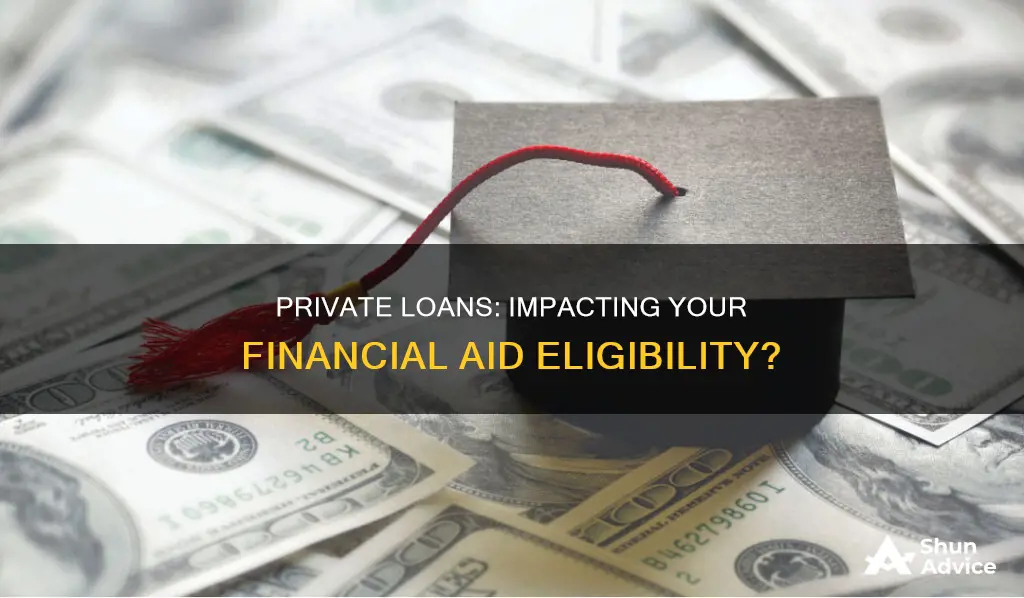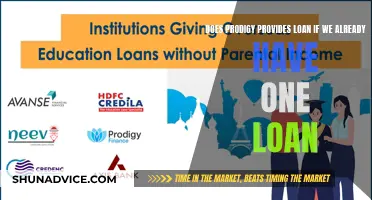
Private loans and federal loans have different features and eligibility criteria. Private loans are not based on financial need and require a credit check, whereas federal loans are based on financial need and do not require a credit check. Private loan funds are usually sent directly to the school's financial aid office, whereas personal loan funds are deposited into the borrower's bank account. The Free Application for Federal Student Aid (FAFSA) determines eligibility for federal student aid and other federal student aid like grants and work-study. FAFSA also considers loans secured by an asset that is reported on FAFSA, where the value of the asset is reduced by the debt against the asset.
Does a private loan affect financial aid?
| Characteristics | Values |
|---|---|
| Interest rates | Private student loans can have either fixed rates that stay the same or variable rates that can change over time |
| Borrowing limits | Private loans may have higher borrowing limits than federal loans |
| Eligibility criteria | Federal loans are based on financial need and don't require a credit check |
| Application process | To apply for federal student loans, the first step is to complete the Free Application for Federal Student Aid (FAFSA) |
| Disbursement | Private student loan funds are usually disbursed directly to the school's financial aid office |
| Repayment | Federal student loans are need-based and have lower, fixed interest rates that stay the same for the duration of the loan |
| Debt | Most consumer debt, including auto loans and credit card debt, is ignored by the FAFSA. Loans are considered on the FAFSA only if they are secured by an asset that is reported on the FAFSA |
What You'll Learn

Private loans are not based on financial need
Private student loan funds are typically sent directly to the school's financial aid office. It's important to note that you will need to plan and allow enough time for the lender to process the loan and send the money to your school. The timing of the disbursement can vary; if you are applying for a full year, the lender may disburse the funds to your school each semester rather than all at once.
To apply for a federal student loan, you need to complete and submit the Free Application for Federal Student Aid (FAFSA). The FAFSA takes into account your family's income and financial circumstances to determine the Student Aid Index (SAI). This figure is then used to calculate the amount of financial assistance you are eligible to receive. Federal student loans are based on financial need and do not require a credit check.
While private loans are not based on financial need, it's important to consider the overall cost of borrowing. Federal student loans typically have lower, fixed interest rates that remain the same for the duration of the loan. On the other hand, private student loans can have either fixed or variable interest rates, which can change over time. Understanding the different interest rates and their potential impact on your loan is crucial when making decisions about financing your education.
Can You Borrow from Your 401(k) Plan?
You may want to see also

Private loans require a credit check
Unlike federal loans, private loans typically require a credit check. This is because private lenders can set their own loan terms, fees, and eligibility criteria. The credit check determines whether you qualify for a loan and what interest rate you will pay.
A high credit score can help you qualify for a competitive interest rate, lowering your monthly payments and long-term costs. On the other hand, a low credit score can make it harder to qualify for a private loan with favourable terms. However, it is not impossible to obtain a private loan with bad credit. One option is to apply with a cosigner, whose credit history will also be reviewed and who will be financially responsible for repayment. Some lenders offer cosigner release after you have made several years' worth of payments on your own. Another option is to explore income share agreements (ISAs), which offer funding based on the degree you are trying to obtain, in exchange for a percentage of your income after leaving school.
If you are considering a private loan, it is a good idea to work on improving your credit score beforehand. The most important factor in your credit score is your payment history, so establishing on-time payment habits for all credit accounts is key. Other steps to improve your credit score include reducing your credit utilization rate and disputing incorrect credit report information.
It is worth noting that while most consumer debt is ignored by the Free Application for Federal Student Aid (FAFSA), loans secured by an asset that is reported on the FAFSA will be considered. In this case, the value of the asset is reduced by the debt against it. For example, the net asset value of a stock market investment is reported by subtracting any margin loans from the investment's market value.
Private Borrowing: Demand and Supply Dynamics Explored
You may want to see also

Private loans may have higher borrowing limits
Private loans are not based on financial need, unlike government loans. This means that borrowers may have to pass a credit check to prove their creditworthiness. As a result, private loans may have higher borrowing limits than federal loans.
To apply for a federal loan, you need to fill out the Free Application for Federal Student Aid (FAFSA). This application determines your eligibility for federal student aid like grants and work-study, as well as federal student loans. The FAFSA takes into account your income and family circumstances to determine the Student Aid Index (SAI), which is used to calculate the amount of assistance you're eligible to receive.
Private loans, on the other hand, can be applied for at any time, as long as you plan enough time for the lender to process and disburse the funds. Private student loan funds are usually sent directly to the school's financial aid office, whereas personal loan funds are deposited into the borrower's bank account. It's important to note that you will have to pay back both federal and private loans, so understanding the repayment terms and staying organized is crucial.
While private loans may offer higher borrowing limits, they also typically have higher interest rates than federal loans. Federal student loans have lower, fixed interest rates that stay the same for the duration of the loan, whereas private student loans can have either fixed or variable rates. Variable rates can change over time, so it's important to understand the different interest rates and their potential impact on your loan.
Principal's Influence: Loan Approval's Unseen Factor
You may want to see also

Private loan funds are sent directly to the school's financial aid office
Private student loan funds are typically sent directly to the financial aid office of the borrower's school. This is in contrast to personal loan funds, which are deposited directly into the borrower's bank account.
Private student loans are not based on financial need, unlike federal loans. Borrowers may need to pass a credit check to prove their creditworthiness, and those with little or no credit history or a low credit score may need a co-signer on the loan. Private loans may have higher borrowing limits than federal loans.
To apply for federal student loans, borrowers need to complete and submit the Free Application for Federal Student Aid (FAFSA). The FAFSA determines eligibility for other federal student aid like grants and work-study. To receive federal student aid, borrowers must submit the FAFSA.
Borrowers can apply for private student loans at any time, as long as they plan enough time for the lender to process the loan and disburse the money to the school. If applying for a full year, the lender may disburse the funds to the school each semester rather than all at once. It is recommended that borrowers always submit their FAFSA first if they think they might need to borrow both federal and private student loans.
Prequalification: A Loan Guarantee or Just a First Step?
You may want to see also

Private student loans can have either fixed or variable rates
When it comes to financing your education, it's important to understand the different types of loans available and how they work. Private student loans are one option, and they can come with either fixed or variable interest rates. So, what does this mean for you?
With a fixed-rate private student loan, the interest rate remains the same throughout the entire term of the loan. This means that you'll have predictable and consistent monthly payments, making it easier to budget and plan for the future. The interest rate you agree on when you take out the loan will not change until the day it's fully repaid. However, keep in mind that private lenders may charge prepayment penalties for paying off the loan early, so be sure to check with your lender.
On the other hand, variable-rate private student loans can change throughout the life of the loan. These interest rates are typically adjusted based on market rates and the Federal Reserve interest rate. While a variable rate can be beneficial if interest rates are falling, it can become more expensive if rates rise. Variable rates may be risky in a volatile market, especially if you plan to pay off the loan over several decades.
Your decision between a fixed or variable rate on a private student loan depends on your comfort with risk and your financial situation. Factors such as your credit score, income, and market conditions will also influence the interest rate offered by private lenders. It's important to shop around and compare different lenders' rates to find the best option for you.
Additionally, it's worth noting that federal student loans have fixed interest rates, and they offer benefits such as income-driven repayment plans and forgiveness programs, which are not available with private loans. Understanding the differences between federal and private student loans can help you make informed decisions about financing your education.
Prime Lending: Selling Loans and Mortgage Deals
You may want to see also
Frequently asked questions
Private loans are not based on financial need and are not considered on the Free Application for Federal Student Aid (FAFSA). Therefore, a private loan will not affect your financial aid.
You can check your loan paperwork and monthly statements to determine if your loan is federal or private. If you think you have a federal loan, log into the Federal Student Aid website with your FSA ID to confirm.
To apply for a federal loan, you need to complete and submit the FAFSA. The FAFSA determines your eligibility for federal student aid, including grants and work-study.
Federal loans are based on financial need and have lower, fixed interest rates that stay the same for the duration of the loan. Private loans may have higher borrowing limits and usually have a fixed or variable interest rate. Private loan funds are typically disbursed directly to the school's financial aid office, while personal loan funds are deposited into the borrower's bank account.







